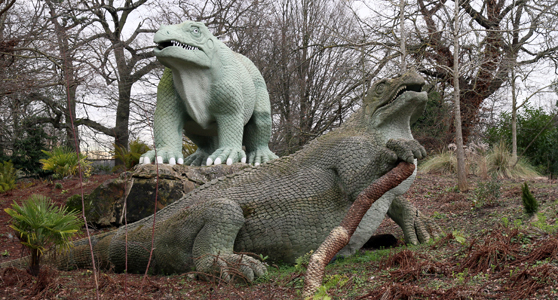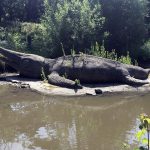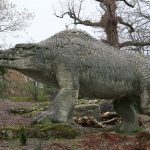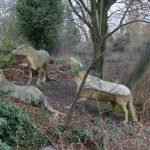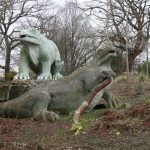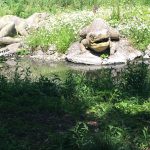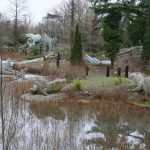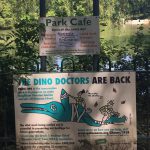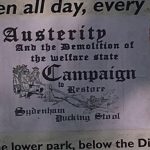A discourse with deep time: the extinct animals of Crystal Palace Park as heritage artefacts
Abstract
https://dx.doi.org/10.15180/191102/001When the Crystal Palace at Sydenham opened in 1854, the extinct animal models and geological strata exhibited in its park grounds offered Victorians access to a reconstructed past – modelled there for the first time – and drastically transformed how they understood and engaged with the history of the Earth. The geological section, developed by British naturalists and modelled after and with local resources was, like the rest of the Crystal Palace, governed by a historical perspective meant to communicate the glory of Victorian Britain. The guidebook authored by Richard Owen, Geology and Inhabitants of the Ancient World, illustrates how Victorian naturalists placed nature in the service of the nation – even if those elements of nature, like the Iguanodon or the Megalosaurus, lived and died long before such human categories were established. The geological section of the Crystal Palace at Sydenham, which educated the public about the past while celebrating the scale and might of modernity, was a discursive site of exchange between past and present, but one that favoured the human present by intimating that deep time had been domesticated, corralled and commoditised by the nation’s naturalists. Initially, the claim that extinct animals were aligned with British national heritage was a construction that matched the agenda of the Crystal Palace Company. Over time, the extinct animal models themselves (rather than the animals they represented) became historical artefacts recognised as heritage assets.
Keywords
Crystal Palace, dinosaurs, extinct animals, heritage, palaeontology
Introduction
https://dx.doi.org/10.15180/London. Michaelmas Term lately over, and the Lord Chancellor sitting in Lincoln’s Inn Hall. Implacable November weather. As much mud in the streets, as if the waters had but newly retired from the face of the earth, and it would not be wonderful to meet a Megalosaurus, forty feet long or so, waddling like an elephantine lizard up Holborn-hill.
Charles Dickens, Bleak House (1852)
‘The Iguanodon…was, as we have already stated, a native of Sussex.’ And ‘the Plesiosaurus was a native of Dorsetshire’ (Anonymous 1854c). In early 1854, this report detailing the progress made on the relocated Crystal Palace and the models of extinct megafauna exhibited in its grounds emphasised the provenance of these creatures, excavated from the fossil-rich rocks of southern England. But the anonymous author’s phrasing is suggestive. Instead of observing that the remains were discovered by local naturalists in Sussex, the article insisted that the Iguanodon itself was the native. That precisely the same phrasing described the indigeneity of the Plesiosaurus to Dorset confirms that contemporary geographies were being cast back into the prehistoric past. By no means was this claim exceptional. Throughout the mid-Victorian period, the British press asserted a relationship among fossils, the land in which they were discovered, and the nation to which this land presently belonged. Fossils were made British by their associations to the geology of Great Britain. But geographic relationship alone does not account for the way in which extinct animals became part of the nation’s patrimony during the nineteenth century. This process reflected the efforts of naturalists like the ‘British Cuvier’, Richard Owen, whose lectures, publications and public displays instructed the British press and people to contemplate geological history alongside human history (Rupke, 2009: 66).
This essay treats the geological section of the Crystal Palace as a case study through which to explore how scientific exhibitions and science communication come to be inflected with the cares of those in charge of interpretation.[1] It further reflects on how this singular and spectacular exhibit ultimately manifested the ideas it promoted. Richard Owen’s guidebook to the extinct animals displayed in the Crystal Palace Park, Geology and Inhabitants of the Ancient World (1854), made these creatures British through rhetoric alone. Yet the models that represented these prehistoric monsters have themselves come to be viewed as significant artefacts and features of British heritage, in part because the reconstructions differ so wildly from current scientific consensus. Over 150 years after the models were first displayed, the extinct animals of the Crystal Palace Park are designated Grade I national monuments, a listing that denotes their superlative historical significance and makes them a high conservation priority (Historic England n.d).

Nationalism at the Crystal Palace
https://dx.doi.org/10.15180/191102/002The Crystal Palace at Sydenham, which opened in June 1854, allowed for the imagined annexation of deep time, for it was in the geological section in the park grounds that the public first came face to face with former worlds.[2] While naturalists had for a few decades been rendering scenes of prehistoric animals and environments, the full-scale models of extinct animals, or ‘antediluvians’, designed and built by Benjamin Waterhouse Hawkins were the first attempt to reconstruct in sculpture a past to which no humans were witness (Peck, 2008, 68–69). A close reading of the geological and palaeontological information presented there alongside the ways in which the public, the press and even the Queen herself engaged with these innovative models, reveals that this second Crystal Palace functioned as a discursive site of exchange between deep past and present. Naturalists imported former worlds into the nineteenth century for the benefit of public edification, but the concerns of the present simultaneously colonised the past. Ultimately, though, the discourse was unbalanced. Through guidebooks and press reports, Victorians visiting the Crystal Palace were encouraged to push back against the overwhelming scale of geological history by relating to the animals and minerals of deep time in terms of contemporary national borders and human affairs. Moreover, naturalists and their audiences celebrated geological and palaeontological materials as local resources and capitalised on their economic and intellectual worth, naturalising them just as Dickens had done in the opening lines to Bleak House.
Like the Hyde Park Great Exhibition of 1851, the Crystal Palace at Sydenham, located south of the Thames, was designed to celebrate the advance of Britain and other ‘civilised’ nations. It was hoped that visitors to the grounds would feel compelled to admire the cultural and technological apogee over which Victoria reigned, after consuming the art, science and industry collected in this venue. Though a private venture overseen by the newly incorporated Crystal Palace Company, this permanent palace at Sydenham echoed the ideals and aims of the earlier, nationally funded exhibition. An article in The Times observed that the Crystal Palace ‘aspires to be, and is recognised, as national’ (Piggott, 2004). Queen Victoria assented to this unofficial affiliation by presiding over the opening ceremonies on 10 June 1854, just as she had done in 1851.
Designed by Joseph Paxton to imitate a botanical conservatory, the new glass palace perched upon a hilltop overlooked pastoral Surrey and Kent on one side, the buildings of London on the other. The panoply of exhibits it contained would have astounded even those visitors who had previously witnessed the Great Exhibition. There were natural history and ethnological displays alongside industrial exhibits celebrating advances in machinery, furniture making, perfumery and textiles. The portraiture, sculpture and architectural reconstructions were to be appreciated for both their aesthetic and didactic qualities. The palace grounds presented still more wonders. The waterworks and manicured gardens just outside the glass building demonstrated a domesticated nature, while the geological section situated at the very bottom of the park invited visitors to learn about an untamed antediluvian world through models of extinct animals and displays of geological stratification. This final exhibit claimed to illustrate the ‘native state’ of England and its animal inhabitants. Located at the very edge of the park, geological strata and replicas of the extractive industries that monetised the minerals discovered in these rocks revealed the resources that funded and fuelled imperial power (MacDermott, 1854: 176–178).
The goal of the geological section aligned with that of the palace in general, to communicate ‘a divinely ordained model of progress culminating in the Victorian period’. Moreover, palace and park designer Joseph Paxton and his collaborators, including geologist David Thomas Ansted and Benjamin Waterhouse Hawkins, the naturalist and artist who sculpted the extinct models, hoped that visitors would leave their exhibit recognising ‘the wondrous diversity of God’s universe’ (MacDermott, 1854: 20). By referring to these extinct animals as ‘antediluvian monsters’ and ‘pre-Adamite beasts’, Hawkins and Richard Owen, who was brought in at a late stage to lend credence to the exhibit through his well-known name and reputation as a comparative anatomist, museum curator and public promoter of science, situated these creatures within a Judeo-Christian narrative, as did many other nineteenth-century naturalists (Secord, 2004: 154-5). Ansted and Hawkins augmented this rhetorical relationship by positioning the fearsome reconstructions upon stratified islands in a lake, which was intended to suggest the biblical flood. The figurative and visual links to Genesis ‘embedded the creatures in a biblical temporality’ familiar to most visitors (Marshall, 2007: 295). Prior to this exhibition, encounters with lost worlds had been reserved for those who studied extinct animals. As Martin Rudwick (2010: 1–2) explains, naturalists had ‘developed a conceptual time-machine’ that allowed these privileged few to ‘burst the limits of time’. The geological section of the Crystal Palace instead offered a more egalitarian form of time travel. Here any Londoner able to afford the entrance fee could spend an afternoon strolling through an English park as it was imagined to have looked during previous geological periods.[3]
Designs on deep time
https://dx.doi.org/10.15180/191102/003The exhibits at Sydenham were governed by what Nancy Rose Marshall (2007: 294) has described as ‘spatial time’. A literal progress narrative, the linear organisation of the Crystal Palace invited visitors to anticipate that Britannia would attain even greater triumphs in the arts and industry than those of the great civilisations of antiquity. The grounds, which terminated at the geological section in the very ‘bowels’ of the park, employed a linear narrative complementary to that of the main building (Marshall, 2007: 291). Entering the park by way of the palace, visitors experienced this progress in reverse. They would encounter gardens and fountains representative of cultured civilisations before meeting ethnological exhibits meant to illustrate prehistoric peoples and arriving ultimately at the reconstructions of long extinct animals and geological formations. Thus they proceeded from historical to pre-historical to geological temporalities in mere moments.
The extinct animals displayed in the geological section were not articulated fossils. They incorporated no organic – or even previously organic – matter. They were enormous sculptures built from iron and cement (choice building materials of the industrial age) meant only to represent the creatures of deep time. This artifice was no secret. Richard Owen lectured and published about the methodology that sculptor Hawkins employed to create these lifelike monsters. Geology and Inhabitants of the Ancient World, the official guide to the geological section which Owen himself wrote, explained that he had chosen to sculpt animals for which ‘the entire, or nearly entire, skeleton had been exhumed in a fossil state’. Having a relatively complete skeletal frame from which to extrapolate the animal’s general shape, Owen explained, Hawkins approximated the organic matter not preserved during fossilisation, such as fatty tissue and skin texture, by drawing analogies to ‘the nearest allied living animals’. This practice of approximation led to disagreements between sculptor and comparative anatomist that played out in the latter’s guidebook. The nasal horns on the Iguanodon models were ‘more than doubtful’, Owen informed his readers. He entirely avoided description of the dorsal hump that Hawkins had added to the Megalosaurus (see Figure 2), though the guidebook’s illustration depicted it without one, a wordless critique of artistic license (Owen 1854: 5–6, 17–21; Secord 2004: 157). Thus, while Owen did not have much influence over the design of the extinct animal models, he did have the power to interpret them for visitors.
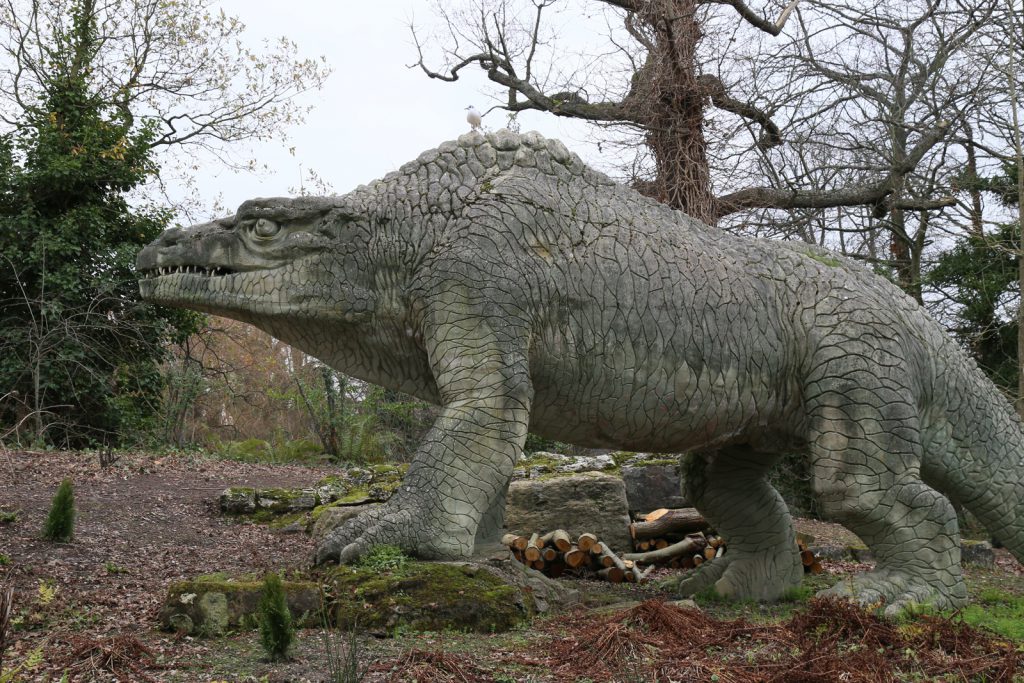
What distinguished the models of the geological section from the art and artefacts displayed in the Crystal Palace itself was their provenance. In his guidebook, Owen traced the regional pedigree of twenty-two models originally displayed in the geological section. Of these twenty-two – which, significantly, did not include all of the exhibited models – only one lacked a relationship to the literal land of England. Incomplete remains of the Megalosaurus had been extracted from the oolitic stratum near Oxford, in Bath, in the Tilgate Forest of Kent, and in various towns of Sussex and Yorkshire (Owen, 1854: 19). Mesozoic marine reptiles called ichthyosaurs were found in the lias stratum of Lyme Regis, and in Bristol, Glastonbury and Gloucestershire. Fellow water dwellers, the plesiosaurs, were frequently discovered in Dorset and Somerset. The Labyrinthodon, represented by Hawkins as a toadlike creature, was found throughout Warwickshire and Cheshire. Mosasaurus, though first discovered on the banks of the Meuse River in Germany from which the marine reptile took its name, was also discovered in the Cretaceous chalk formations of Kent (1854: 11, 29, 38). And so on. The iteration and reiteration in Owen’s guidebook, which lists English counties and towns again and again as the sites of great fossil discoveries, conveys his conviction that the local origins of these animals were significant. Lyme Regis, Tilgate Forest, the Weald of Kent, and Surrey had all yielded spectacular fossils in the decades before the opening of the Crystal Palace. Indeed, the Wealden chalk formation earned its epithet as ‘the metropolis of the “dinosaurs”’ (MacDermott, 1854: 193; Freeman 2004: 1). Even the ‘dog-toothed’ Dicynodon, though found in the sediment of South Africa could be claimed as a British, if not English, product through imperial expansion, for its bones were discovered by Englishman Andrew G Bain, who was stationed at Cape Colony while building military roads (1854: 38–39). The local nature of the fossils on which Hawkins based the majority his models for the geological section made them especially suited for the mission of the Crystal Palace that aimed to set Britain atop the pyramid of civilisations. But the geological section was not a paean to British resources exclusively.
A visitor who relied upon Owen’s guidebook exclusively might assume that all of the creatures modelled in the geological section had British provenance. In fact, a contemporary manual, Routledge’s Guide to the Crystal Palace and Park at Sydenham, and visitor accounts to the park confirm that there were at least a few animal types imported for the geological section – a model of a Megatherium, a giant ground sloth native to the Americas and small herds of the tapir-like Palaeotherium and the camel-snouted Anoplotherium, diminutive mammals that lived in Continental forests and were unearthed from the Paris Basin (Rupke, 2009: 256; MacDermott, 1854: 191–192; McCarthy and Gilbert, 1994: 25, 78–80). Moreover, Hawkins was in the process of constructing a mammoth, and had plans for a mastodon, a massive armadillo-like creature called a Glyptodon, and a Dinornis, the giant moa endemic to New Zealand, when the Crystal Palace Company dismissed him in 1855 due to a lack of funds (McCarthy and Gilbert 1994: 33; Piggott 2004: 163). Owen’s guide was not comprehensive. He failed even to mention Hawkins’ models of Megaceros giganteus, the Great Irish Elk, native to the British Isles, despite the fact that his recently published A History of British Fossil Mammals and Birds included an extended analysis of British cervids and thus demonstrated expertise on these animals (Owen 1846: 444–490; Piggott 2004: 161, 164).
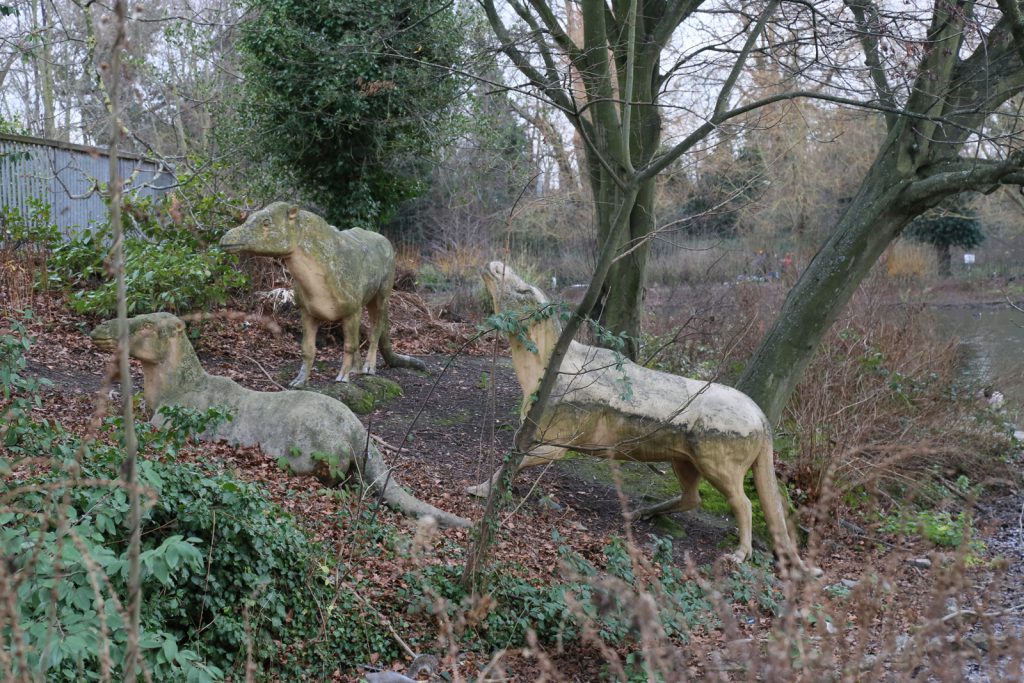
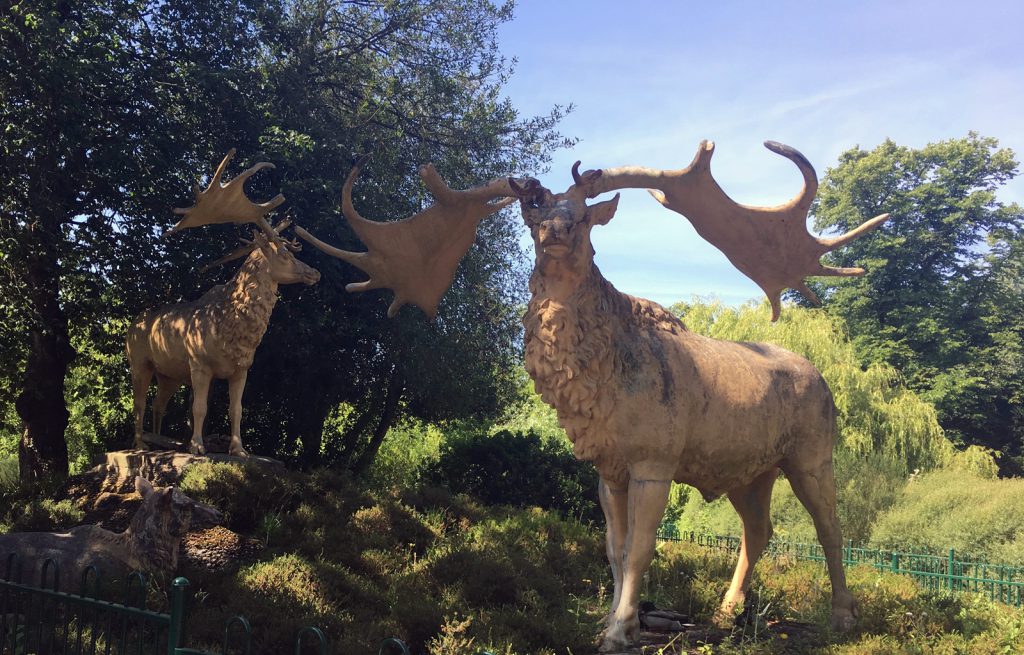
Did Owen’s book simply go to print before all of Hawkins’s models were installed? This could be the case for some of the omissions and certainly accounts for his silence regarding the incomplete Mastodon and Dinornis, but there is something calculated about the creatures Owen elected to describe. Instead of accounting for all of the models displayed in the geological section, his guide exclusively featured the extinct creatures understood as reptiles – all of which were indigenous to the geographic region presently known as England or to British imperial soil. These fossil finds – recently discovered, spectacularly proportioned, bizarrely shaped, as well as local – contributed to a general air of excitement regarding British palaeontology. Owen’s guidebook, in part, capitalised on public enthusiasm for these homegrown discoveries. The Iguanodon was, without question, more sensational than the familiar Great Irish Elk. But his selectiveness also seems to reflect a desire to make deep time manageable and comprehensible to his Victorian audience. The geological past is vast; one must fence it in. Owen corralled geological time by assigning it temporal and geographic boundaries. In publishing Geology and Inhabitants of the Ancient World, a seemingly comprehensive account of the geological section, Owen wielded his authority as anatomist and exhibit interpreter to decide for his audience which extinct animals were to be associated with the nation in the pseudo-national Crystal Palace at Sydenham.
Owen’s effort to place nature in the service of the nation was not confined to this one publication; in fact, it was a principle that governed his life’s work. In 1845, while employed as curator at the Hunterian Museum of the Royal College of Surgeons, he presented a report to its governing body detailing his vision for a national museum of comparative anatomy that would rival Cuvier’s Muséum d’histoire naturelle and other Continental institutions. He petitioned them to transform the collection from something predominately medical to a comprehensive anatomical one in order to accumulate intellectual capital and enhance Britain’s prestige. As Rupke (2009: 44) explains, Owen fervently believed that ‘to collect, to display, to describe, and to lecture about objects of natural history increased [an] institution’s and, by association, [it’s] nation’s “intellectual wealth”’. There was an imperial tone to Owen’s agenda. He described the collecting and consuming of nature as the ‘annexation of fresh territory to the Empire of the Known’. Ultimately, the Royal College of Surgeons rebuffed Owen’s request, but he carried this ‘ideal’ of a national natural history collection with him when he left the Hunterian to take the post of superintendent of the British Museum’s natural history collection in 1856 (Rupke, 2009: 21–22). There he continued to advocate for a dedicated natural history collection, arguing in 1862 that England, as ‘the greatest commercial and colonizing empire of the world’, must ennoble itself with the ‘material symbol’ of progress that a natural history museum would embody (Owen 1862: 126). His mission, subtly furthered by Geology and Inhabitants of the Ancient World, was fulfilled at long last in 1881 when the British Museum unveiled a dedicated natural history museum in South Kensington.
By emphasising the English locales in which these fossils were found and the English men and women who discovered them (Doyle, 2008: 201), Owen’s guidebook made implicit statements about the indigeneity of these ‘pre-Adamite’ animal remains. The revelation that many of these creatures had been exhumed mere miles away inflected Hawkins’ claim about displaying these creatures in their ‘native state’ with a nationalistic note (MacDermott, 1854: 20). A similar claim could be made regarding the materials used for his reconstructions, which were ‘composed of Portland cement’, a binding agent named for its likeness to the fossil-rich stone quarried on the Isle of Portland in Dorset (Adams 1857: 87). Moreover, the geological strata of the Crystal Palace exhibit had a particularly strong claim to autochthony, for David Thomas Ansted insisted that his geological section must display the actual type of geological formations it described rather than simply modelling them. And so he had several tons of stone shipped to Sydenham, bringing in, for example, limestone from Yorkshire and sandstone from Bristol (Piggott, 2004: 164). The historical Fine Arts Courts within the palace had to be imported. But the geological section was a national product through and through. Both the intellects and the resources that produced it were of English or imperial extraction.
The entire geological section would have been impossible but for Britain’s recent industrialisation. The ships and railways that imported the materials, the cement and iron with which Hawkins built his models, and the extractive industries that contributed to major fossil finds were all hallmarks of the industrial age. Most significant to the practice of Victorian geology was the expansion of Britain’s infrastructure. Canal building and railway construction, which required engineers to dig deep into the earth, exposed new geological formations to which geologists flocked (Freeman, 2004: 43–44). The public, too, relied on this infrastructure for access to geological information; the majority of visitors to the palace and park arrived by railway lines, some of which were built exclusively for the Crystal Palace (Piggott, 2004: 60). In recognition of their debt to the industrial age, the designers of the geological section incorporated it into their exhibit. According to the linear organisation of the Crystal Palace, the bottom limits of the park were to display the oldest and most remote geological strata (Doyle and Robinson, 1993: 182–193). Here was installed a coal formation and the limestone that Ansted had brought in from Yorkshire. Within the limestone were two simulated veins of lead and beneath them in a chamber constructed for the purpose, ‘a faithfully correct model of the Matlock lead mine in Derbyshire’ (MacDermott, 1854: 202). By modelling how the earth’s ancient matter had been commoditised by this industrial nation, the exhibit collapsed geological and human temporalities. It demonstrated humanity’s control over the environment as well as its mastery of the past, for the coal with which Britain fuelled its expansion and the other extracted minerals on which its growing infrastructure depended were material traces of past worlds. Thus the geological section of the Crystal Palace, while educating the public on the geological formations and inhabitants of an antediluvian world, at the same time celebrated the scale and might of modernity.
Consuming the past
https://dx.doi.org/10.15180/191102/004By exhibiting a contemporary mining venture in the most remote region of the park, the geological section upset the linear narrative of the Crystal Palace and suggested a contemporaneous relationship between past and present. This possibility resonated throughout the palace and park, for despite its relatively chronological design visitors could choose their own paths. They could experience temporalities out of order or consume them all at once, collapsing geographical and temporal distances. Stephanie Moser (2012: 154–155) suggests that comparison among the Fine Arts Courts was the unavoidable result of their proximity. A balcony elevated visitors and allowed them to ‘contemplate the art of past nations at a single glance’. This visual and material ‘panorama of antiquity’ transformed contemporary Victorians’ relationship to the past by facilitating physical engagement between ‘historical’ periods and the modern one.
Naturalists themselves acted out the intimate relationship between past and present in spectacular form. Most famously, Hawkins hosted a dinner for fellow naturalists within the hollow mould of his massive Iguanodon, an event that garnered prolonged press attention and ensured that his monstrous models would be alive in the imagination of the British public months before the Crystal Palace opened. It was on the last day of 1853 that Hawkins welcomed twenty-eight men of science into his studio to inspect the progress he had made in constructing the ‘members of his monster family’. Twenty-one of them squeezed within the massive girth of the ‘carcass’ for dinner, prompting the author of Routledge’s Guide to declare the animal ‘a true Briton’ on account of its robust waistline. The men toasted the intellects of pioneering palaeontologists such as the late Georges Cuvier, the recently deceased Gideon Mantell (who had described and named the extinct animal in which they men dined), the ailing William Buckland, and Richard Owen, who was in attendance and seated in the skull, at the literal head of the table (MacDermott, 1854: 20, 194; Bramwell 2008: 24–5). Deep time and modernity were conflated in the belly of the beast, which was understood by Victorians as a doubly impressive feat of engineering. That such a massive and strange creature ever existed reflected the skill of a Creator, while its material presence in the nineteenth century spoke to the immense labour, intellect and skill of the naturalists who reconstructed it (see Figure 5).[4]
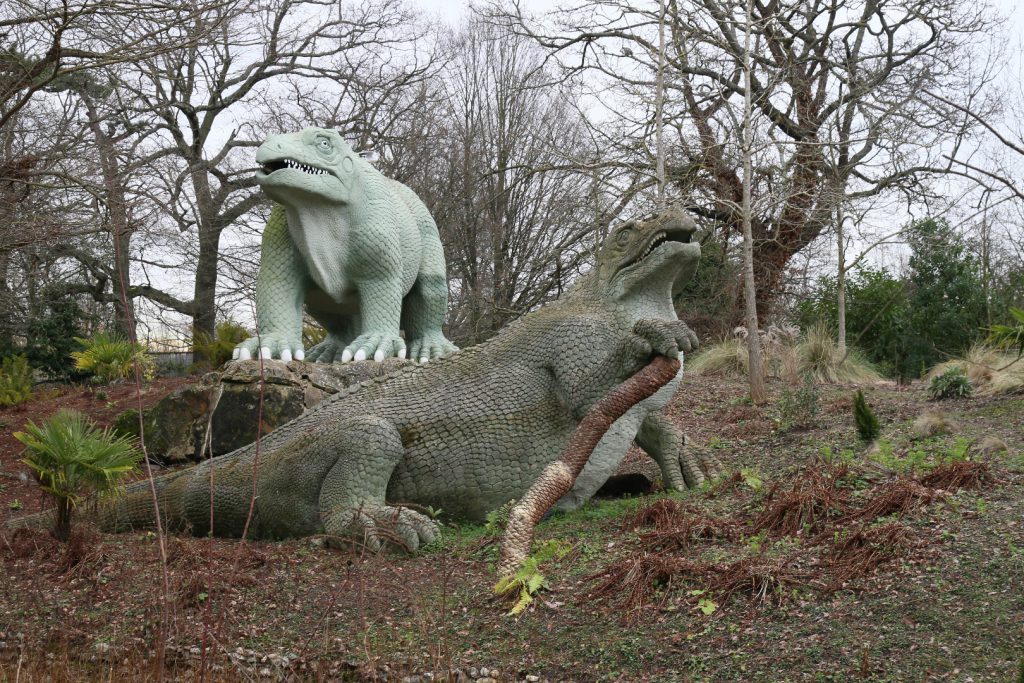
Though a model, Hawkins’ Iguanodon did, figuratively, come to life, enlivened by the men within it. Edward Forbes, a geologist and a poet, was inspired to compose a few verses while dining inside the mould. The poem emphasised the creature’s now animated nature:
Beneath his hide he’s got inside
The souls of living men,
Who dare our Saurian now deride
With life in him again?
All joined in for the chorus, declaring:
The jolly old beast
Is not deceased,
There’s life in him again. (a roar)
Scientific inquiry and industrial technology had brought these creatures back to life, but the resurrection functioned on a more literal level, too. According to one account, the men had joined their voices together in song ‘in a manner so fierce and enthusiastic, as almost to lead to the belief that a herd of iguanodons were bellowing from some of the numerous pit-falls in Penge Park, in which they had been entrapped’ (MacDermott, 1854: 21–22).[5]
It was of course fortunate for the men in attendance that the creatures in Hawkins’ studio were only lifelike and not actually alive. Punch commented, ‘We congratulate the company on the era in which they live; for if it had been an early geological period, they might perhaps have occupied the Iguanodon’s inside without having any dinner there’ (Anonymous, 1854e: 4). Giving thanks that these beasts no longer lived was a common refrain. Queen Victoria had paid a visit to the Crystal Palace when it was still under construction. She inspected the palaeontological models and conversed with Hawkins about ‘the mysteries of antediluvian existence’ (Anonymous, 1854a: 3). The Queen was particularly astonished at the size of the Iguanodon. The King of Belgium, her uncle, was overheard joking that he was grateful this creature was ‘not now one of your subjects’ (Anonymous, 1854c: 3). Britain was eager to benefit economically and intellectually from its fossil resources and inserted these extinct reptiles into the nation’s historical narrative by labelling them ‘natives’, but the discourse between geological past and human present was never an evenly matched conversation. The past was only made present on Britons’ terms. They would not allow it to consume them.
Visitors to the park performed just this sentiment by breaking off bits of Hawkins’ models, typically targeting the teeth. That Hawkins had sculpted many of his models with open jaws and bared teeth, an artistic choice that advertised both the animals’ fearsome nature (a detail that contemporary newspapers were quick to sensationalise) and the importance of dental fossils to palaeontological practice, practically invited this type of theft, especially once the statues started to deteriorate from constant exposure to the elements (Marshall, 2007: 292; Secord, 2004: 161). The past, especially a reconstructed and inorganic one, could not respond. Yet, it was precisely this fear of being consumed by the ages that troubled Victorians. The unfamiliar forms of Hawkins’ figures were visual evidence of extinction and unsettled the Palace’s triumphalist plot by intimating that one day the visitors too would be members of an extinct race. The exhibits in the Crystal Palace hinted as much, too, for the Fine Arts Courts celebrated once glorious but now defunct civilisations. Together with the geological section’s reconstructions of prehistoric forms of life, the Crystal Palace and its grounds functioned as a collective mausoleum to a former world. Jan Piggott (2004: 75) observes that the palace’s parade of the past ‘suggested a certain politics of empire, a philosophy and even a morality: the fall of proud, wealthy and luxurious civilisations’. Was Britain next?
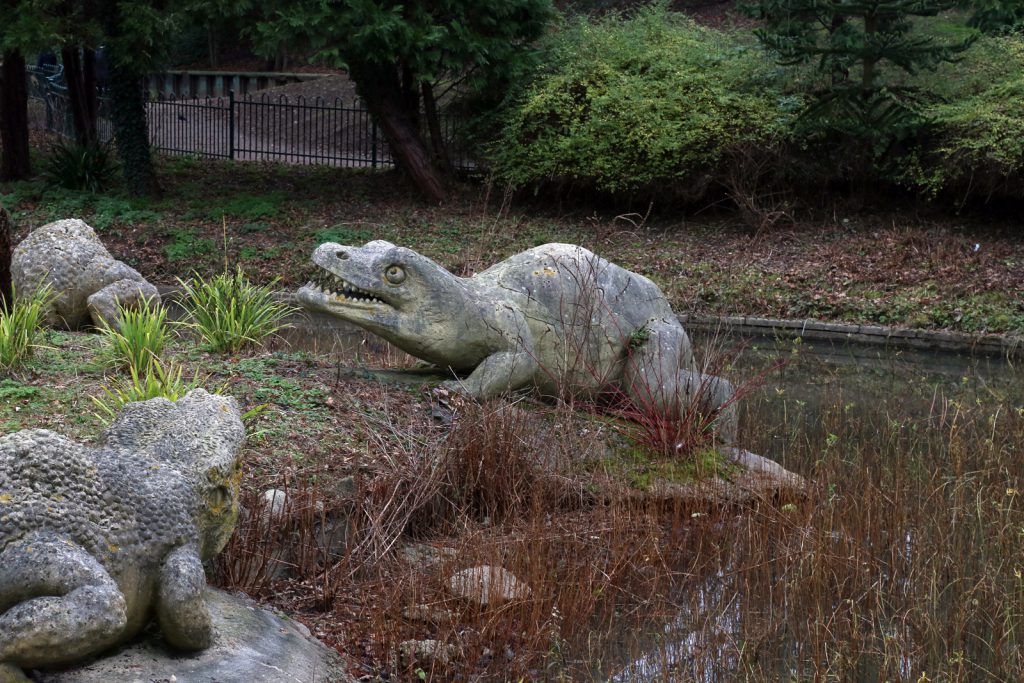

According to the geological section, the answer to this question was a resounding no, because while the lessons of former worlds caused anxieties about the trajectory of a British Empire that was, according to this very exhibition, at the height of its power, the geological and palaeontological models communicated a more hopeful message. Deep time had been domesticated, corralled and commoditised by British naturalists. The song composed by Edward Forbes from within the belly of Hawkins’ Iguanodon reflected the presentist nature and patriotic possibilities of the palaeontology presented at Sydenham. What began with a description of the scientific resurrection of an extinct beast –
A thousand ages underground
His skeleton had lain;
– concluded with hopeful praise for the improvements that the ‘People’s Palace’ would bestow upon the nation.
Though savage war her teeth may gnash,
And human blood may flow,
And foul ambition, fierce and rash,
Would plunge the world in woe.
Each column of this palace fair
That heavenward soars on high,
A flag of hope shall on it bear,
Proclaiming strife must die!
And art and science far shall spread
Around this fair domain,
The People’s Palace rears its head
With life in it again.
Forbes’ verses (MacDermott, 1854: 21–22) transformed the Iguanodon into the Crystal Palace itself, enlisting deep time to the service of the human present. What Forbes did in meter, British naturalists and engineers accomplished in fact, converting the fossils and other minerals extracted from English rock into the intellectual and economic capital that would power the nation and its empire.
The afterlife of Hawkins’ extinct animal models
https://dx.doi.org/10.15180/191102/005The Crystal Palace burned to the ground in 1936, but its extinct animal models survived. ‘Once the pride of Victorian London, the gardens and the monsters are the playground of youngsters,’ noted the narrator of a Pathé News reel shown at cinemas in 1950. ‘So [the monsters] lie, a reminder of two distant ages. The prehistoric and the age of our grandfathers’ (British Pathé, 1950). Familiar to generations, Hawkins’ statues were a part of local history. While the world they channelled was understood to epitomise Tennyson’s ‘Nature, red in tooth and claw’, having survived the war nearly unscathed, they also hearkened back to a time before the Blitz, when Britons fought their wars far from home. Over the decades, the park became a part of everyday life in South London. Newsreels produced around the mid-century mark demonstrated the absurd, yet naturalised quality of the century-old statues. A man walks his dog through the park and women push prams and tote toddlers, the youngsters seemingly unafraid of the extinct ‘monsters’ that loomed over them. Children frequently clambered atop the statues, contributing to peeling paint and overall deterioration. Footage captured in 1950 showed two young boys darting around on the Iguanodons’ island. The boys scampered under the one that stands of all fours like a mammal – the mould for which had hosted Hawkins’ New Year’s Eve banquet in 1853 – and through a hole in the belly climbed into the hollow form. Having shimmied into the head of the statue, one boy waved frantically at the camera from behind the fearsome teeth (British Pathé, 1950; British Pathé, 1954). Once regarded as scientific models, Hawkins’ work had become the playthings of local children.
Initial efforts to conserve the statues, obdurate but not invulnerable to the elements, began in the 1950s, as the empire began to fragment, alongside a resurgence in popular interest in the Victorian era (Secord, 2004: 165). Workers added fresh cement to restore the crumbling statues and fresh coats of paint to those that were only slightly weathered by the years (British Pathé, 1959). In 1973, the ‘prehistoric animal sculptures, geological formations and lead mine on islands and on land facing lower lake’ were all added to a register of designated heritage assets, presently called the National Heritage List for England, as Grade II buildings, an official category that established the entire geological section of the Crystal Palace Park as ‘of more than special interest’. After three decades, the models were upgraded to Grade I buildings, now recognised as of ‘exceptional interest’ and a high conservation priority (Historic England n.d.; Doyle and Robinson, 1993: 188; McCarthy and Gilbert, 1994: 85). Official recognition of cultural and historical significance has facilitated further restoration projects and the reconstruction of some of the ‘geological illustrations’ that had been destroyed. And once again English resources were used. In the 1990s, the Borough of Bromley brought in ‘110 tonnes of replacement Carboniferous Limestone’ sourced from Derbyshire as before, to recreate some of Ansted’s lost work and to conserve the prehistoric animals, the largest of which Hawkins had built and reinforced more like ‘buildings’ than sculptures (Doyle, 2008: 201, 203–4).
The most recent restorations have been overseen by the Friends of Crystal Palace Dinosaurs, a charity organised in 2013 that deploys the term ‘dinosaur’ loosely to encompass all of the prehistoric animals on display in the park. As Ralph O’Connor (2012: 494) has demonstrated, the use of the word to describe the statues is, beyond being a categorical overstatement, anachronistic. For while Richard Owen coined it in 1842, the popular adoption of the term dinosaur in place of ‘antediluvians’ and ‘extinct monsters’ would not happen for another fifty years. The Friends’ express mission is ‘to ensure the dinosaurs survive our generation intact, so they can be enjoyed for future generations’. In addition to offering public engagement programmes, lecture series and resources that communicate the Victorian history of the site, the Friends collect stories from people who use the park to this day. The group also raises funds to repair the crumbling models and organises the Palaeo Planting Project, a community effort of volunteer labour to introduce plants deemed ‘historically and scientifically appropriate’ and to weed out those determined inappropriate (Friends of Crystal Palace Dinosaurs, (‘Reviving lost worlds’) and (‘Who are Friends’) n.d.).[6]
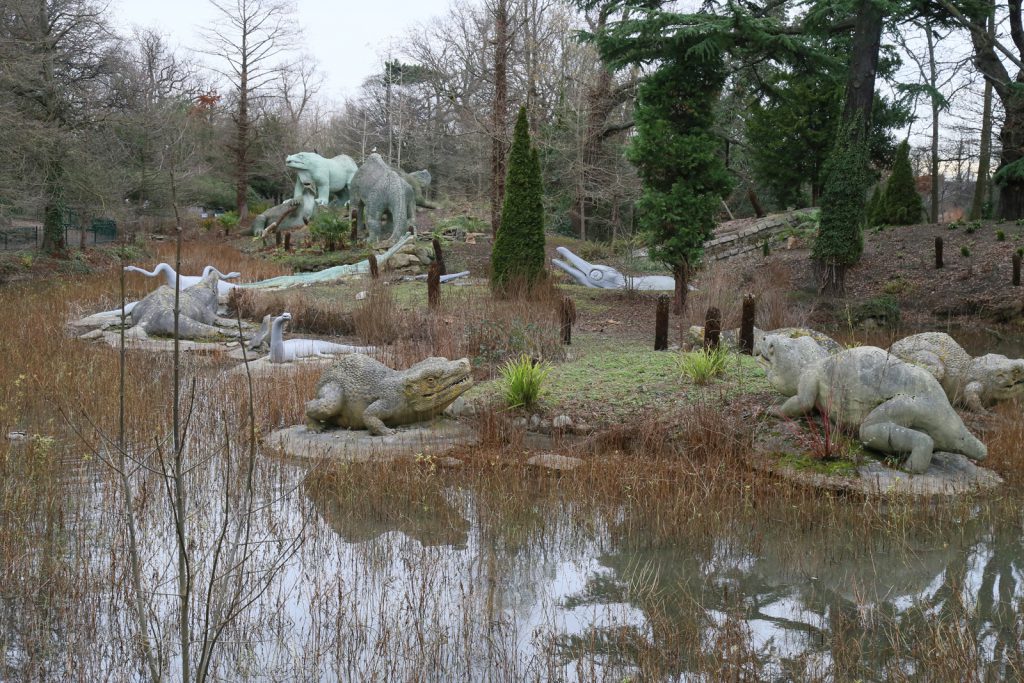
During fair weather, visitors to the Crystal Palace Park may see conservators at work on the models. Signs installed throughout the park in the summer of 2017 announced, ‘The Dino Doctors Are Back’ for phase two of conservation work on ‘seven magnificent Victorian Saurian marvels off Dinosaur Island’. Playful illustrations depicts a woman wrapping bandages around an Ichthyosaurus, while a man tends to its tail and another man cares for a Teleosaurus. The work is, according to these signs, ‘vital’ and ‘essential to preserving our heritage for future generations’ (see Figure 9). Another sign, which boasts that the Friends are ‘Bringing History to Life’ shows the female conservator brushing the Ichthyosaur’s teeth while her colleague strokes a Plesiosaur’s neck as if getting to know a horse (see Figure 10). Just as Richard Owen did in his guidebook, the Friends of Crystal Palace Dinosaurs strategically emphasise specific models in promotional and fundraising materials, focusing on the extinct animals of the Mesozoic while leaving out mention of the modelled mammals.
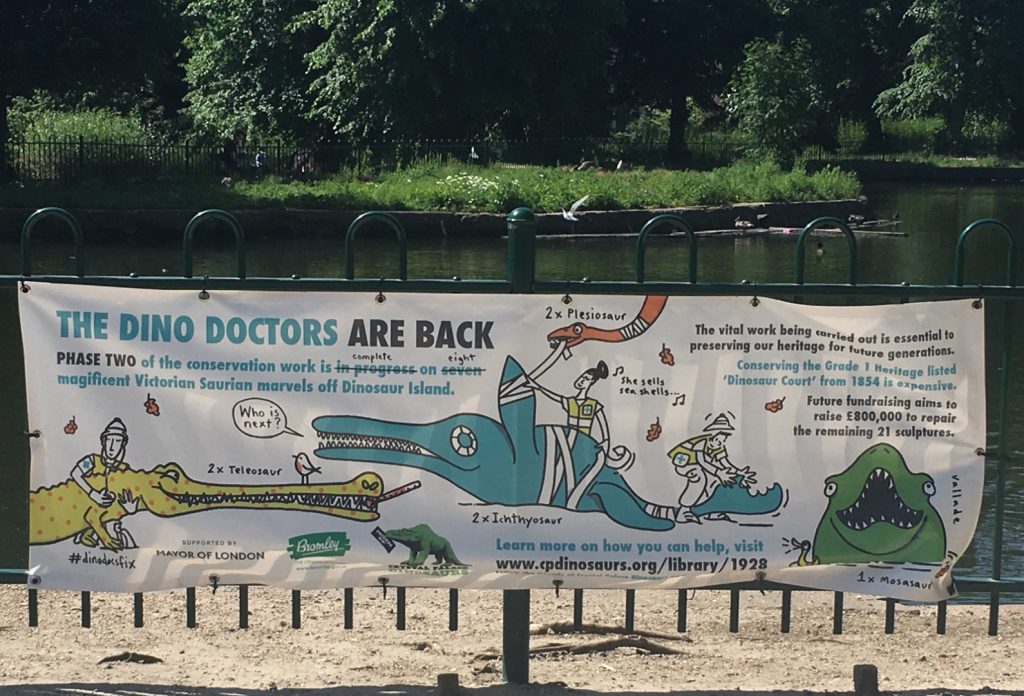
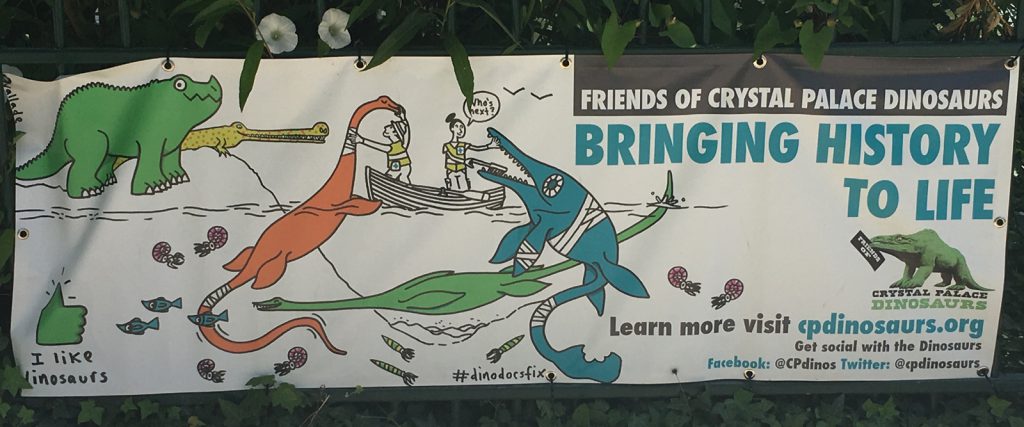
Conclusion
https://dx.doi.org/10.15180/191102/006The discourse with deep time continues and, indeed, it is fostered by the Friends who ‘encourage [visitors] to draw their own meaning from the site’ (Friends of Crystal Palace Dinosaurs, ‘Who are Friends…’ n.d.,). Such discourse is idiosyncratic and often ephemeral; and yet, some of these interactions do leave material traces. The practice of postering over signs in the park, for instance, is a manifestation of contemporary public engagement with the prehistoric animal models. Visitors who saw conservators working on phase two of conservation work on the ‘Victorian Saurian marvels’ during the summer of 2017 may have also spotted fliers posted about the park that lambasted austerity politics through satire (see Figures 11 and 12).[7]
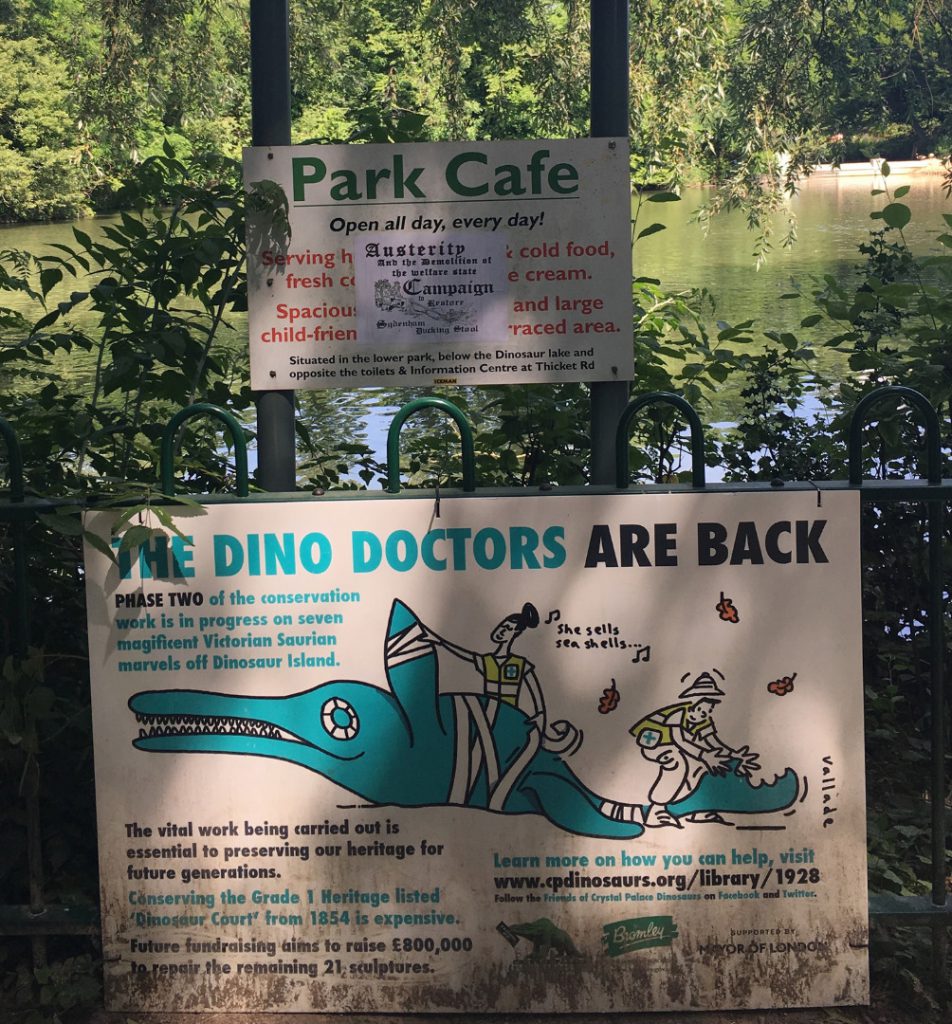
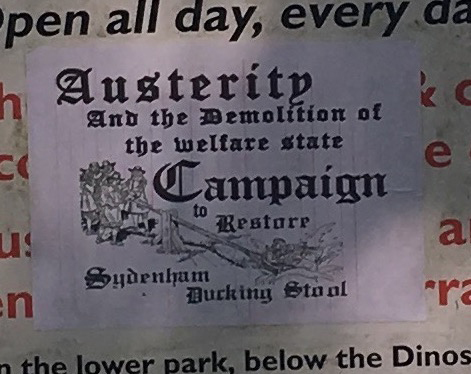
An unsanctioned posting interrupts the official sign that informs visitors about the Park Cafe’s operation hours and offerings. Black gothic font on plain white paper states, ‘Austerity and the Demolition of the Welfare State Campaign to Restore Sydenham Ducking Stool’. A line drawing depicts men lowering a woman into water upon said ducking stool, an absurd and heavily gendered punishment that was used for centuries to censure individuals in public settings, though the practice fell out of use by the early nineteenth century, well before the debut of the geological islands in the Crystal Palace Park (Underdown, 1985). The flier offers no other details, but the absurdity of its platform signals that it must be satire. Like the theft of cement teeth in the 1850s, the practice of postering is a material way through which the public asserts a relationship with the Crystal Palace models and the park that hosts them. Moreover, the critique of national policy that this particular poster puts forward resonates with the easily undone progress narrative that Victorian visitors to the Crystal Palace would have experienced as they took in, simultaneously, the wonders of former empires along with the message that these empires, no matter how grand, ultimately fell (Piggott, 2004: 75).
In some instances, exhibitions are ephemeral experiences. More often, though, displays outlast the context of their creation. Though scientifically obsolete, the extinct animal models of the Crystal Palace Park have survived to become significant historical and cultural artefacts and familiar facets of London life. The models have witnessed a half-dozen British monarchs, survived wars and weathered the end of an empire, while generation upon generation of visitor encountered Victorian visions of the land’s prehistoric past.[8] ‘We don’t own the dinosaurs. Everybody does,’ the Friends of the Crystal Palace Dinosaurs declare on their website, for ‘they are a heritage asset owned by the public’. Though, the Friends clarify, it is the borough of Bromley that serves as their ‘legal custodian’ (Friends of Crystal Palace Dinosaurs, ‘Who are Friends…’ n.d.). The Friends have here offered a revision on the claims made by Richard Owen and the British press about extinct animals and national patrimony. According to the Friends and the heritage sector that they work within, it is not the extinct animals but the models representing them that are particularly British, at once historical artefacts and heritage assets.
Tags
Footnotes
Back to text
Back to text
Back to text
Back to text
Back to text
Back to text
Back to text
Back to text

